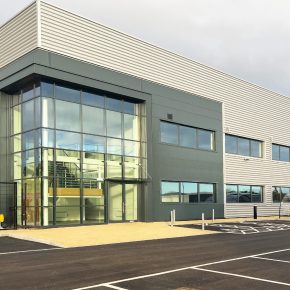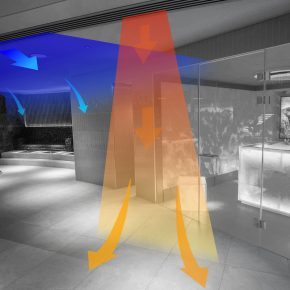
Refrigeration and freezer solutions can reduce bills at supermarkets
Further reductions can be achieved if heat recovered from the refrigeration process is used to provide space heating and hot water
With around 50-70% of a supermarket’s energy costs being attributable to refrigeration, it is estimated that 30-50% of retail display energy consumption could be cut by making energy efficiency improvements. This equates to a £19,500 annual energy bill for a 2,000ft2 sales area convenience store, or even up to £45,000 for a store open 24 hours a day.
The report highlights the efficiency improvements that could achieve the greatest energy savings, which include optimising settings on existing equipment, retrofitting transparent doors on display units, replacing condensing units and installing heat recovery solutions as part of system upgrades.
Inverter-controlled refrigeration systems using scroll compressors are a good choice to replace standard condensing units. These inverter-controlled condensing units are particularly suitable for the fluctuating loads and high energy efficiency requirements of retail stores. They can deliver a range of temperatures for both low temperature (-20°C to -45°C) and medium temperature (10°C to -20°C) applications to power cold rooms, freezers, chilled and frozen food cabinets.
Inverter control ensures that operation is maintained at the lowest possible speed to meet cooling demand.Refrigeration systems with inverter controls also have shorter start-up times, as the required temperature is reached more quickly and temperature fluctuations are avoided. This technology also gives high levels of energy efficiency, even in partial load conditions, resulting in reduced operating costs and decreased CO2 emissions.
Independent retailers spend on average, £9,750 to £22,500 per site annually on refrigeration energy
For all these reasons, an inverter controlled condensing unit was chosen by Cold Service for a McColls convenience store in Fareham. Mark White, design manager for Cold Service, said: Energy efficiency was a highpriority for our client and this, coupled with the surrounding residential area where low noise was an important factor, led us to specify the Daikin ZEAS system. Its small footprint meant that it was the ideal fit for the restricted outside space.
The model chosen was a medium temperature unit, able to deliver temperatures from -20°C to 10°C. With a capacity of 25kW, the unit offers energy efficiency levels of up to 300% (COP of 3.0), yet it has a small footprint of just 930 x 765mm and very low sound pressure levels of just 41dB(A) at 10m, making it a suitable solution for this project.
We are monitoring both the noise and the energy efficiency levels at the store so that we can evaluate exactly how good the figures are. We were extremely happy with the performance and ease of installation and are looking forward to analysing data from the test results.
Further reductions can be achieved if heat recovered from the refrigeration process is used to provide space heating and hot water. Daikin’s CVP refrigeration system, for example, uses the same VRV technology as the ZEAS range and can halve energy use. The system, which also has a small footprint, recovers up to 100% of the heat extracted from refrigeration cases and re-uses it to heat the retail space via ceiling cassettes or over-door air curtains, at no additional cost, while also improving comfort conditions in store.
Inverter-controlled refrigeration systems using scroll compressors are a good choice to replace standard condensing units
A combined CVP and ZEAS system was installed by Eiskalt (UK) on behalf of operator Hills of Corby Hill at a Spar store and petrol filling station at Whitehaven in Cumbria. One CVP condensing unit serves four large display cases and one smaller display case, all with glass doors, at -6°C evaporating temperature. The outdoor unit is able to provide 20.72kW of refrigeration, up to an ambient temperature of 35°C and provide up to 37.5kW of heat in winter or 13.51kW of cooling in summer, via three ceiling cassettes.
The ZEAS condensing unit serves three more display cases, also fitted with glass doors and with an evaporating temperature of -6°C, providing a total of 8.15kW refrigeration capacity up to an ambient temperature of 35°C.
For larger stores, a new range of Multi ZEAS units has just been launched, which deliver the higher capacities required for supermarkets, food storage and processing plants, while reducing energy consumption when compared with traditional refrigeration systems.
So, whatever size of refrigeration system is required, there are now solutions for every scale of retail operation, which could assist in achieving the potential cost-savings identified by the Carbon Trust.
Latest news

2nd April 2025
FIT Show 2025 Launches Innovative Marketplace Feature to Enhancing Value for Installers
FIT Show, the UK’s leading event for the window, door, flat glass, hardware, and roofing industries, is excited to announce the launch of a brand new Marketplace feature at its upcoming 2025 event (Birmingham NEC, 29 April – 1 May).
Posted in Architectural Ironmongery, Articles, Building Industry Events, Building Industry News, Building Products & Structures, Doors, Exhibitions and Conferences, Glass, Glazing, Hand Tools, Innovations & New Products, Plant, Equipment and Hire, Power Tools, Restoration & Refurbishment, Retrofit & Renovation, Roofs, Seminars, Training, Windows
2nd April 2025
Hi-spec deployment of EJOT Colorfast at new Birmingham logistics park
EJOT Colorfast fasteners have been used extensively in the construction of eight new high-specification warehousing and logistics buildings at the Urban 8 Logistics Park in King’s Norton, Birmingham.
Posted in Articles, Building Industry News, Building Products & Structures, Building Systems, Case Studies, Facades, Restoration & Refurbishment, Retrofit & Renovation, Roofs, Walls
2nd April 2025
SWA member delivers ‘fresh Hope’ for university’s Sustainable Building department
A detailed contract to restore an iconic Art Deco building in the heart of Birmingham’s Jewellery Quarter was carried out by Steel Window Association member, The Window Repair Company (Northwest) Limited.
Posted in Articles, Building Associations & Institutes, Building Industry News, Building Products & Structures, Building Systems, Case Studies, Glass, Glazing, Restoration & Refurbishment, Retrofit & Renovation, Steel and Structural Frames, Sustainability & Energy Efficiency, Windows
1st April 2025
Gilberts Takes Thermal Comfort to New Heights
Gilberts Blackpool is continuing to build on its reputation as a pioneer with the unveiling of ThermaAstute™ – the most extensive range of thermally sensitive diffusers in the market.
Posted in Air Conditioning, Articles, Building Industry News, Building Products & Structures, Building Services, Facility Management & Building Services, Heating, Ventilation and Air Conditioning - HVAC, Innovations & New Products, Restoration & Refurbishment, Retrofit & Renovation, Sustainability & Energy Efficiency
 Sign up:
Sign up: